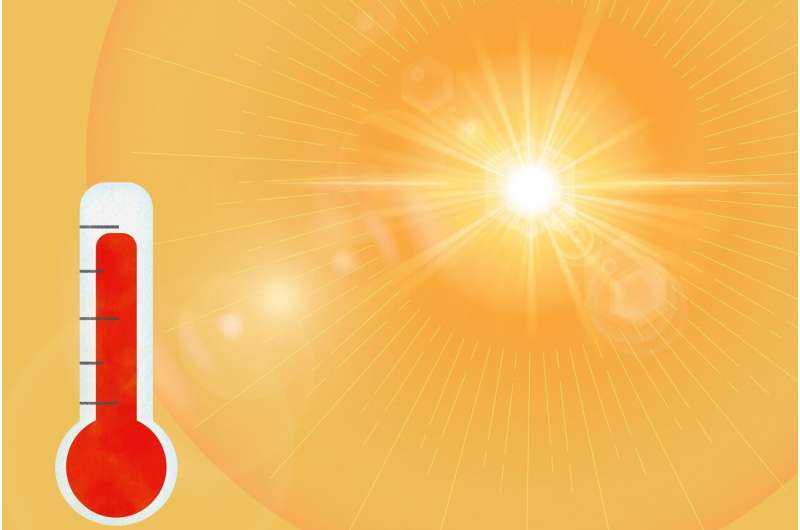Global heat wave in summer accelerates melting of mountain glaciers in China
The world experienced an unprecedented heat wave in 2022, and this long duration and extreme heat wave event aroused widespread concern. Heat wave events have a huge impact on the global melting of glaciers.
Urumqi Glacier No. 1 is the only one in China with more than 30 years of continuous glaciological mass balance measurements, which can probably reflect glacier status at large scales.
A research team led by Prof. Wang Feiteng from the Northwest Institute of Eco-Environment and Resources of the Chinese Academy of Sciences documented the response of glacier mass balance to extreme heat based on the extensive in situ mass balance measurements of Urumqi Glacier No. 1.
The study is published in Journal of Glaciology.
The researchers found that the net mass balance of Urumqi Glacier No. 1 in 2022 was -1,251 mm, slightly higher than the lowest net mass balance observed in 2010.
In addition, the summer mass balance of Urumqi Glacier No. 1 in 2022 reached the lowest value since the observation record (1958–2022), which was -1,503 mm, indicating that the summer of 2022 was the largest material loss year since the record of Urumqi Glacier No. 1.
The results showed that the summer temperature in 2022 observed by Daxigou Meteorological Station near Urumqi Glacier No. 1 was 6.4°C, which was the maximum temperature since the observation record, and the heat wave caused a strong material loss of Urumqi Glacier No. 1.
The researchers also found that the heat wave caused intense glacier melting in higher elevation areas, and the high temperature caused the proportion of solid and liquid precipitation in glacier areas to decrease.
When the temperature was higher than 2°C, the proportion of solid precipitation in the source area of Urumqi River was less than 40%, and the average daily temperature in 2022 summer was higher than 2°C indicating that liquid precipitation was the main precipitation in glacier areas.
In addition, glaciers absorbed more shortwave solar radiation due to the lower albedo of the glacier surface, which accelerated glacier melting.
Landsat remote sensing image inversion results showed that the glacier surface albedo was relatively low during the strong ablation season (July–August) in 2022, the proportion of surface albedo less than 0.3 was 79%–91% of the total glacier area.
More information:
Chunhai Xu et al, Heatwaves in summer 2022 forces substantial mass loss for Urumqi Glacier No. 1, China, Journal of Glaciology (2024). DOI: 10.1017/jog.2024.4
Citation:
Global heat wave in summer accelerates melting of mountain glaciers in China (2024, January 30)
retrieved 30 January 2024
from https://phys.org/news/2024-01-global-summer-mountain-glaciers-china.html
This document is subject to copyright. Apart from any fair dealing for the purpose of private study or research, no
part may be reproduced without the written permission. The content is provided for information purposes only.

The world experienced an unprecedented heat wave in 2022, and this long duration and extreme heat wave event aroused widespread concern. Heat wave events have a huge impact on the global melting of glaciers.
Urumqi Glacier No. 1 is the only one in China with more than 30 years of continuous glaciological mass balance measurements, which can probably reflect glacier status at large scales.
A research team led by Prof. Wang Feiteng from the Northwest Institute of Eco-Environment and Resources of the Chinese Academy of Sciences documented the response of glacier mass balance to extreme heat based on the extensive in situ mass balance measurements of Urumqi Glacier No. 1.
The study is published in Journal of Glaciology.
The researchers found that the net mass balance of Urumqi Glacier No. 1 in 2022 was -1,251 mm, slightly higher than the lowest net mass balance observed in 2010.
In addition, the summer mass balance of Urumqi Glacier No. 1 in 2022 reached the lowest value since the observation record (1958–2022), which was -1,503 mm, indicating that the summer of 2022 was the largest material loss year since the record of Urumqi Glacier No. 1.
The results showed that the summer temperature in 2022 observed by Daxigou Meteorological Station near Urumqi Glacier No. 1 was 6.4°C, which was the maximum temperature since the observation record, and the heat wave caused a strong material loss of Urumqi Glacier No. 1.
The researchers also found that the heat wave caused intense glacier melting in higher elevation areas, and the high temperature caused the proportion of solid and liquid precipitation in glacier areas to decrease.
When the temperature was higher than 2°C, the proportion of solid precipitation in the source area of Urumqi River was less than 40%, and the average daily temperature in 2022 summer was higher than 2°C indicating that liquid precipitation was the main precipitation in glacier areas.
In addition, glaciers absorbed more shortwave solar radiation due to the lower albedo of the glacier surface, which accelerated glacier melting.
Landsat remote sensing image inversion results showed that the glacier surface albedo was relatively low during the strong ablation season (July–August) in 2022, the proportion of surface albedo less than 0.3 was 79%–91% of the total glacier area.
More information:
Chunhai Xu et al, Heatwaves in summer 2022 forces substantial mass loss for Urumqi Glacier No. 1, China, Journal of Glaciology (2024). DOI: 10.1017/jog.2024.4
Citation:
Global heat wave in summer accelerates melting of mountain glaciers in China (2024, January 30)
retrieved 30 January 2024
from https://phys.org/news/2024-01-global-summer-mountain-glaciers-china.html
This document is subject to copyright. Apart from any fair dealing for the purpose of private study or research, no
part may be reproduced without the written permission. The content is provided for information purposes only.
